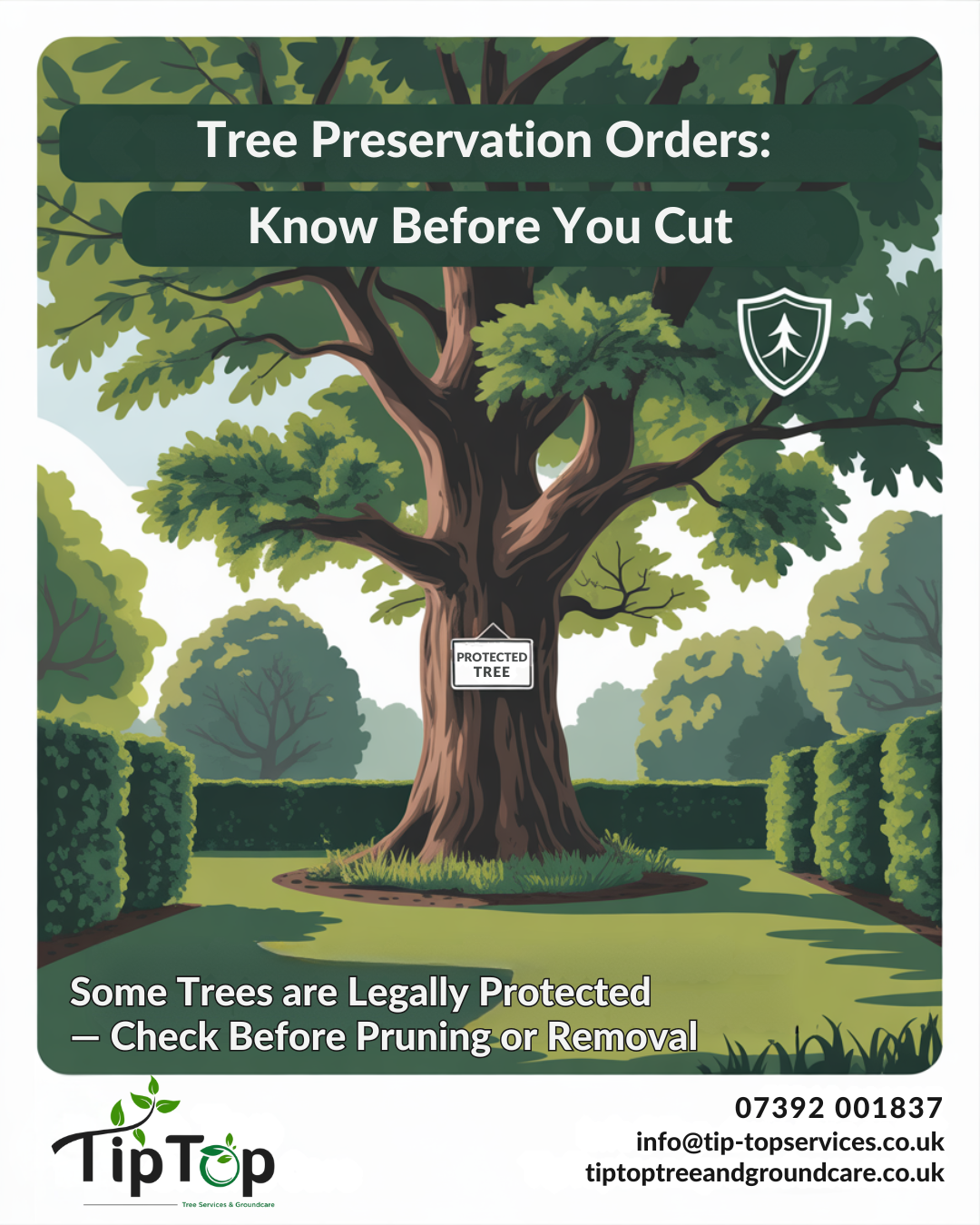Protecting Trees, Property & Peace of Mind
If you own a property with mature or established trees, it’s important to understand how Tree Preservation Orders (TPOs) work. These legal protections ensure trees are managed safely and responsibly.
At Tip Top Tree & Ground Care, we’re often asked, “Can I prune, trim, or remove a tree with a TPO?” The short answer — only with permission. But knowing how to check, what’s allowed, and when to apply for consent can save you from costly mistakes and fines.
This guide breaks down everything you need to know about TPOs in the UK.
What Is a Tree Preservation Order (TPO)?
Tree Preservation Orders in the UK are legal protections made by your local planning authority (LPA) to prevent unnecessary cutting, lopping, or damage to valuable trees.
The purpose is simple: to prevent unnecessary cutting, lopping, topping, uprooting, or damage. Trees protected by a TPO are considered valuable to the local environment and community.
How to Find Out If Your Tree Has a TPO
- Check with Your Local Council
- Contact your local planning department or check their online map.
- Most councils now provide digital “TPO map viewers” where you can search your property.
- Ask Before You Act
- If you’re unsure, always assume a tree might be protected and get confirmation first.
- Acting without permission can lead to prosecution.
- When in Doubt, Call a Professional
- Tip Top Tree & Ground Care can check TPO status for you and handle all communication with the council.
What You Can and Can’t Do Under a TPO
You Can:
- Apply to prune or remove a protected tree through your council (via a formal TPO application).
- Carry out urgent safety work if a tree poses immediate danger — but you’ll need to provide evidence afterward.
- Maintain dead branches or remove storm-damaged sections with prior approval.
You Can’t:
- Cut, lop, top, uproot, or damage a TPO-protected tree without written consent.
- Carry out works that indirectly harm the tree (e.g., trenching or paving near roots).
Unauthorised work on a protected tree can result in fines of up to £20,000 in Magistrates’ Court or unlimited fines in Crown Court.
How to Apply for Permission
The process for requesting tree work under a TPO is straightforward but must be handled carefully:
- Submit a Tree Work Application Form to your local council.
- Include a clear description of the work (e.g., “reduce crown by 25% to remove deadwood”).
- Attach photos or a professional arborist report.
- Wait for written approval (typically within 6–8 weeks).
Tip Top can manage this process from start to finish — ensuring your request complies with BS 3998:2010 Tree Work – Recommendations, which councils often refer to when assessing applications.
Why Trees Receive TPO Protection
Local authorities typically issue TPOs for trees that are:
- Visually important to the community (landmark or heritage trees).
- Of special ecological or historical value.
- Under threat from proposed development.
- Contributing to local biodiversity and air quality.
TPOs help ensure that important trees remain part of the landscape for future generations.
🛠 How Tip Top Tree & Ground Care Can Help
We understand how confusing TPO laws can seem — especially when you just want to maintain your garden safely. That’s why our team provides:
- TPO checks and council liaison
- Professional tree reports and inspection letters
- Safe, compliant pruning and maintenance
- Emergency storm response and evidence documentation
All our work is carried out under BS 3998:2010 recommendations, ensuring full legal and environmental compliance.
Quick Tips for Homeowners
-
Before pruning or removing any tree, check whether a Tree Preservation Order (TPO) applies to it.
-
Keep clear photographs of storm damage or decay to support any application for consent.
-
Remember, routine maintenance isn’t always permitted under TPO protection — always confirm first.
-
For safety and compliance, hire a qualified arborist who understands council procedures and BS 3998 standards.
Frequently Asked Questions (FAQs)
Q1: How do I check if a tree is protected by a TPO?
You can check your local council’s online map or call their planning department directly.
Q2: Can I cut down a TPO tree if it’s dead or dangerous?
Yes, but you must provide evidence (e.g. photos or arborist reports) and notify the council.
Q3: Who enforces TPO laws?
Your local planning authority. They can issue fines or legal notices for unauthorised work.
Q4: Can I appeal a TPO decision?
Yes. If permission is refused, you can appeal to the Planning Inspectorate within 28 days.

Tree Preservation Orders: Know Before You Cut
At Tip Top Tree & Ground Care, we handle all aspects of Tree Preservation Orders, from identifying protected trees to managing TPO applications and compliant pruning.
Unsure if your tree is protected? Don’t risk costly fines. Let Tip Top Tree & Ground Care handle your TPO checks, council applications, and compliant tree work.
📧 Email: info@tip-topservices.co.uk
📞 Phone: 07392 001837
🌐 Website: tiptoptreeandgroundcare.co.uk
👉 Check out our recent blogs on tree safety, winter garden preparation, and hedge care for more expert guidance.
Follow us for updates:
- Instagram: Tip Top Instagram
- Facebook: Tip Top Facebook
References
- GOV.UK – Tree Preservation Orders and Conservation Areas
- Arboricultural Association – Tree Work Guidance
- HSE – Tree Work Safety
- BS 3998:2010 Tree Work Recommendations (BSI)

